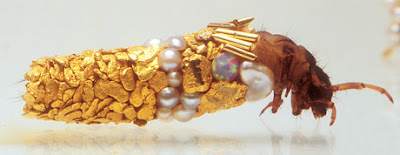Caddis fly jewellery
Caddis fly larvae build protective cases using materials found in their environment. French artist Hubert Duprat supplied them with gold leaf and precious stones including opal and turquoise. This is what they created. They are beautifully gross or disgustingly beautiful depending on how you see it. Interesting to see the patterns and combinations created by nature.
The images above illustrate the results of an unusual artistic collaboration between the French artist Hubert Duprat and a group of caddis fly larvae. A small winged insect belonging to the order Trichoptera and closely related to the butterfly, caddis flies live near streams and ponds and produce aquatic larvae that protect their developing bodies by manufacturing sheaths, or cases, spun from silk and incorporating substances—grains of sand, particles of mineral or plant material, bits of fish bone or crustacean shell—readily available in their benthic ecosystem. The larvae are remarkably adaptable: if other suitable materials are introduced into their environment, they will often incorporate those as well.
Duprat, who was born in 1957, began working with caddis fly larvae in the early 1980s. An avid naturalist since childhood, he was aware of the caddis fly in its role as a favored bait for trout fishermen, but his idea for the project depicted here began, he has said, after observing prospectors panning for gold in the Ariège river in southwestern France. After collecting the larvae from their normal environments, he relocates them to his studio where he gently removes their own natural cases and then places them in aquaria that he fills with alternative materials from which they can begin to recreate their protective sheaths. He began with only gold spangles but has since also added the kinds of semi-precious and precious stones (including turquoise, opals, lapis lazuli and coral, as well as pearls, rubies, sapphires, and diamonds) seen here. The insects do not always incorporate all the available materials into their case designs, and certain larvae, Duprat notes, seem to have better facility with some materials than with others. Additionally, cases built by one insect and then discarded when it evolves into its fly state are sometimes recovered by other larvae, who may repurpose it by adding to or altering its size and form.Via Cabinet Magazine





Comments